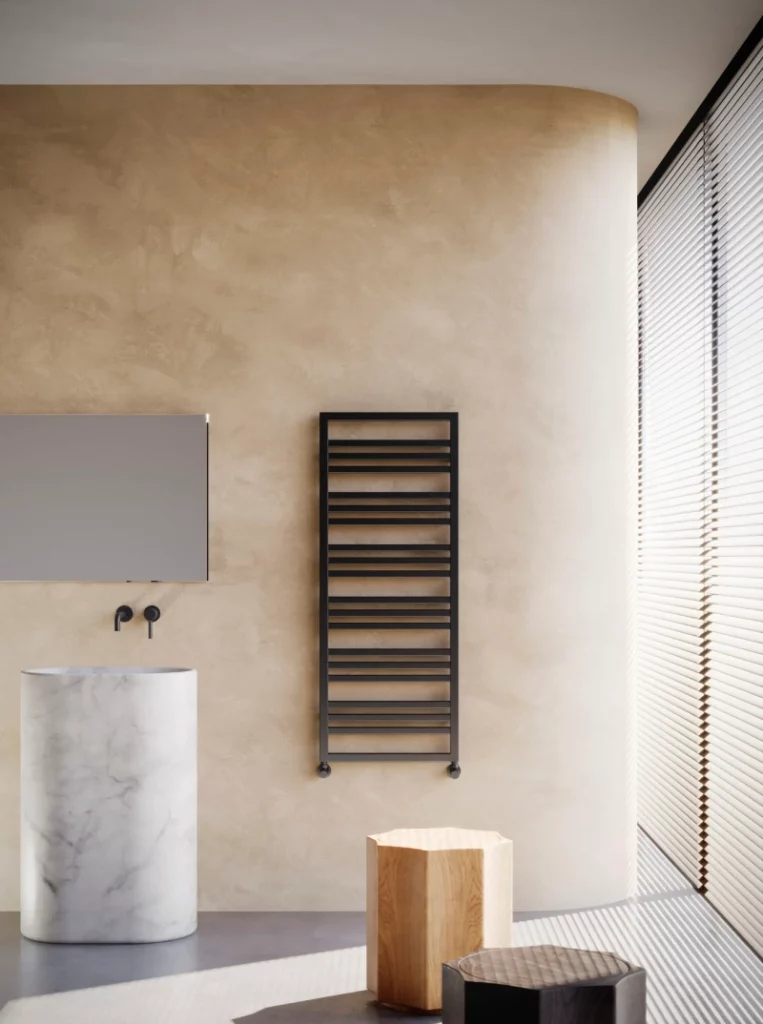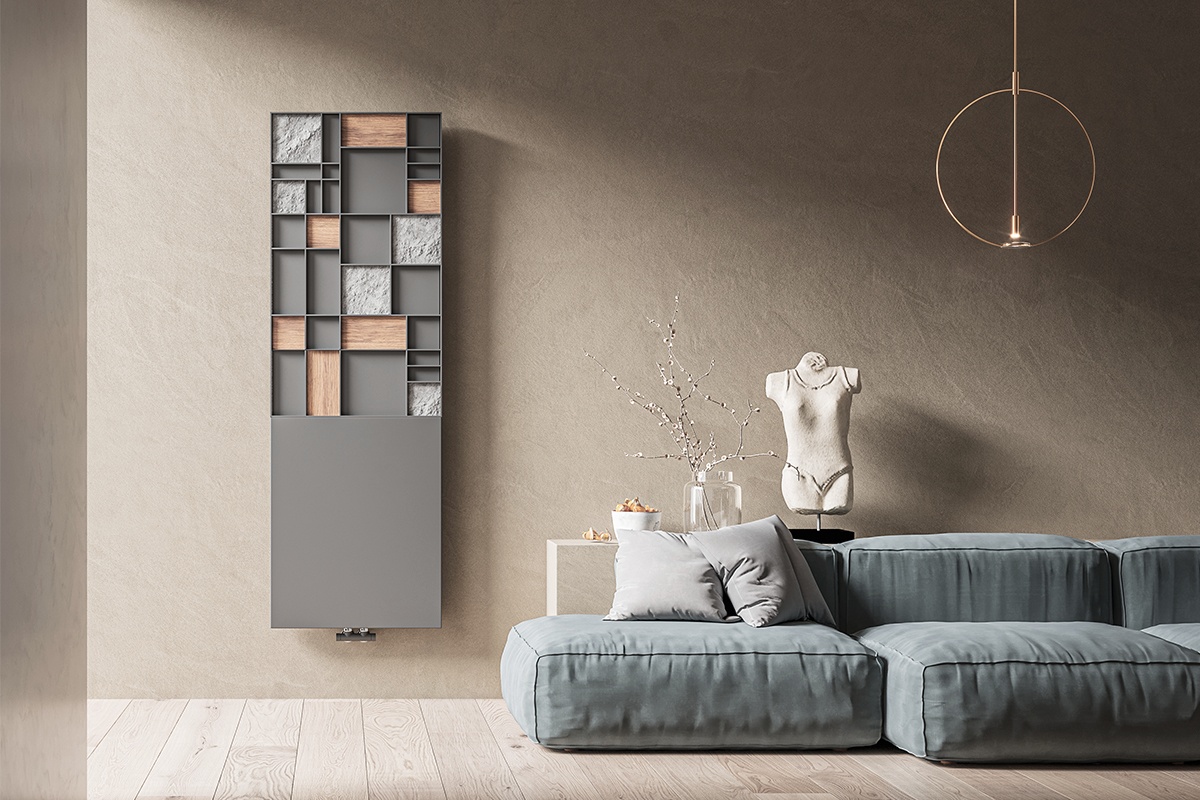There was a time when a bathroom heater was considered a luxury in the average home, but thanks to modern technology, smart design, and better materials, they are now much more affordable. Towel warmers provide essential room heating and offer the practicality of warming bath towels.
Contemporary bathroom vanity designs come in a wide variety of styles and colors. Traditional towel warmers often feature a classic white column design with chrome or gold finishes. The size of your room and available wall space will determine how large your bathroom heater can be, but with the variety of shapes and sizes available, even smaller rooms can benefit from such an item.
Our complete guide to bathroom heating will cover the selection, installation, and maintenance of your bathroom heater to help you make the best choice and achieve the perfect finish for your space.

Types of Towel Warmers
A towel warmer can be a stylish addition to an existing radiator in a larger bathroom or serve as a standalone heat source for smaller rooms. They are both practical and aesthetically pleasing, with various designs and color options that enhance any bathroom style. Installing the unit is relatively straightforward, provided you have some confidence in DIY projects.
If you lack DIY experience, we recommend hiring a handyman. For electric or dual rail models, it’s essential to use a qualified electrician for installation, as the unit connects to the mains.
Before installing the towel warmer, ensure it fits in the designated space. If you are renovating the room, it is much easier to paint or tile the area before installation, so we suggest doing that first. You may need to make adjustments to the subfloor piping, so it’s best to leave the flooring for later just in case. Make sure your central heating system is completely turned off and drained.
If you are replacing an existing towel warmer with one of the same dimensions, the process should be straightforward, provided the piping is in the same position. If the new warmer has a slightly wider or narrower profile, you may need a plumber to adjust the existing piping, especially if it comes from the floor rather than the wall.
The most common reason to replace towel warmer valves is to upgrade to thermostatic valves, which allow for adjustable heat output. These valves enable the radiator to turn on when the room drops to a certain temperature and turn off once it reaches a desired warmth. Valves may also need replacing if they are damaged or for aesthetic reasons.
Maintaining Your Towel Warmer
It’s important to maintain your towel warmer, just like any radiator, to ensure it operates efficiently. It is recommended to bleed the radiators annually or when making any changes or repairs to the heating system. If your towel warmer is warm at the bottom but cooler at the top, it likely indicates trapped air in the system, preventing water from circulating properly. You can easily bleed the towel warmer without professional help using a radiator key or flat-head screwdriver, a wrench, and a cloth.
Steps to Bleed Your Towel Warmer:
- Turn off your heating and allow the system to cool for at least 30 minutes.
- Open the radiator valves and remove any caps, turning them fully counterclockwise with a wrench.
- Locate the bleed valve, usually hexagonal or square, at the top or back of the towel warmer.
- Place a cloth under the bleed valve and turn it counterclockwise. You will hear a hissing sound as air escapes. Once water begins to flow, close the valve.
- If air escapes but no water comes out, you may need to increase the pressure in your system.
Cleaning Your Towel Warmer
Regular maintenance will extend the life of your towel warmer and ensure optimal performance. Bathroom radiators, often used in bathrooms, kitchens, and utility rooms, accumulate dust and dirt over time. Therefore, it’s important to clean them regularly. Modern towel warmers can be easily wiped down with a soft, damp cloth to remove dust and dirt, ensuring they look good and function efficiently.
Electric and Dual-Powered Towel Warmers
If you don’t have a gas central heating system, you can install an electric towel warmer connected to the mains. The advantage of an electric model is that it can be turned on only when needed, making it energy-efficient and cost-effective. Some come with a thermostat for adjustable heat output, while others have a fixed output.
Many people choose dual-powered towel warmers that combine heated and electric options. This flexibility allows you to use the warmer independently of the mains or simultaneously with your central heating system, which is especially useful in the summer when central heating is rarely used.
Heating Your Bathroom with Towel Warmers
Towel warmers connected to a central heating system operate similarly to standard radiators but typically emit less heat. While you can leave bathroom radiators on continuously, it is safer to limit the use of electric models and only switch them on when necessary.
When considering a towel warmer, think about its intended use. If you primarily want to warm towels, you won’t need as much power compared to heating the room. For an average bathroom measuring about 2.5m x 2.5m, a heater with a heat output of around 1150 BTU is recommended. Generally, larger towel warmers provide higher heat output, and using an online heating calculator can help determine the appropriate BTU for your specific room.
Where to Place Your Towel Warmer
Consider the placement of your new towel warmer for convenience, ease of use, and aesthetics. Key factors include:
- Whether you are replacing an existing warmer
- Available space
- Room shape
- Wall space
- Whether the unit is plumbed, electric, or dual
- Position of existing pipelines
- Placement of doors and furniture
- Size of the towel warmer
If you intend to use the warmer for both heating the room and warming towels, position it where heat can radiate freely without obstruction from doors or furniture. Ideally, this would be on the coldest wall, near a window, or another exterior wall to enhance heat distribution.
Additionally, place the warmer close to your tub or shower for easy access to warm towels. Take measurements and consider the size of both the towel warmer and the wall it will be mounted on. Be mindful of any restrictions regarding pipe placements, and consult a registered professional if you are unsure.
Installation and Maintenance
Installing a bathroom towel warmer should not be overly complicated if you have some DIY experience. If you need further assistance, don’t hesitate to reach out to a professional for help. https://bg-maistor.com/
Feel free to let me know if you need any further adjustments!






